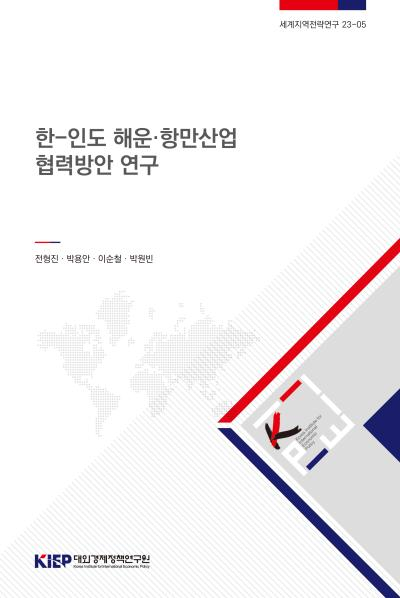Working Papers
Publications
Working Papers
To list

A Study on Korea-India Shipping and Port Industry Cooperation
economic growth, economic cooperation
Author Hyung-JIn Chun, Yong-An Park, Soon-Cheul Lee, and Wonbin Park Series 23-05 Language Korean Date 2023.12.29
The purpose of this study is to propose cooperation measures in shipping and ports between Korea and India. To achieve this goal, we propose specific cooperation measures and policy tasks between the two countries. To this end, in Chapter 2, this study identified the cooperation environment in India’s shipping and port sectors in connection with the growth of the Indian economy. In Chapter 3, it examined India’s shipping and port policies and the current status of companies. In Chapter 4, it examined India’s shipping and port policies and the current status of companies. Shipping and port logistics infrastructure was analyzed focusing on the Chennai and Kolkata regions. In addition, Chapter 5 identified the demand for cooperation between Korea and India and proposed cooperation plans in shipping, ports, and international multimodal transportation, and Chapter 6 presented cooperation plans and demonstrations in shipping, ports, and international multimodal transportation between Korea and India based on the analysis results in Chapter 5. Promotion tasks for each project and related ministries and institutions were proposed.
In Chapter 2, it was discovered that India’s shipping and ports pursued policies such as modernization of ports, expansion of connectivity, port-led industrialization, and improvement of logistics efficiency under the Modi government. Due to the rapid growth of the Indian economy, shipping volume has also increased rapidly, and the role of major ports such as JNPT and Mumbai Port has increased significantly. Indian merchant ships are small, and the shipbuilding industry is small compared to the size of the economy, so containerization is insufficient. However, there is high development potential as trade diversification expands along with economic growth in the future. If the high growth trend of the Indian economy continues, the complementary relationship between Korea and India will further expand, and the possibility of using Indian shipping and ports is higher, so a foundation for cooperation is needed.
In Chapter 3, it was identified that India’s shipping and port policies are shifting to respond to India’s expanded role following the reorganization of the global supply chain. The Indian government is proposing various policies focusing on improving infrastructure related to shipping logistics, and related investments are also being made. Although companies in Indian shipping ports are small, they have ample growth potential, and the use of containers is expected to increase through logistics standardization, so there is a need to explore cooperation strategies in related fields. Accordingly, there is a high possibility of participation in port redevelopment and new port development, and it is possible to participate in terminal operation in the form of a merger with related companies.
Chapter 4 shows that India’s major ports have high potential in terms of their roles and competitiveness, and that ports in the three major regions are pursuing various projects and policies to strengthen port competitiveness, such as port modernization, strengthening connectivity, and strengthening internal capabilities. Three major ports, including Navasheva Port, Paradiv Port, and Chennai Port, account for most of the container cargo. Fossil fuels are mainly handled by Dindaya Port, Mumbai Port, and Paradiv Port. Ports in India’s three major regions were evaluated to have secured transportation networks for each port in response to the rapid increase in cargo volume, improved internal infrastructure, and secured logistics networks connecting roads and railroads. In India, various projects such as port modernization, connectivity enhancement, and internal capacity building are being promoted by the central government, local governments, and individual port organizations, and the construction of additional terminals is being promoted for each port. In addition, it is important to secure complex logistics bases at each major base to improve land logistics conditions.
In Chapter 5, in order to specify international cooperation in the shipping and port sectors, the demand for cooperation between Korea and India was reviewed and general areas of cooperation were proposed. For this purpose, a review of existing literature, interviews with container shipping companies, expert interviews, AHP techniques, and ODA expert inverview were utilized. Summarizing the results using this methodology, the areas that should be considered priority for cooperation between the two countries are port construction and operation. Of these, container terminal construction should be considered first, followed by cooperation on new port construction and operation. must be reviewed. Next, it is necessary to expand the customs clearance agency business into areas including multimodal transportation that can provide door-to-door transportation. Meanwhile, for ODCY and ICD, there were difficulties in purchasing land, obtaining permits, and complicated procedures when entering new markets, so it was concluded that taking over the existing system was appropriate.
Chapter 6 proposes cooperation measures and pilot projects in the shipping and port sectors between Korea and India based on the results of Chapter 5. In detail, the shipping market is concerned with regular container transportation and other shipping, shipbuilding, and port construction operations. Cooperation plans and pilot projects were proposed for new port construction, existing ports, port hinterland linkage infrastructure, port hinterland logistics centers, etc., and port/ rear area complex transportation, respectively, for customs clearance agency and forwarding, trucking, ODCY, and ICD. In addition, comprehensive opinions on cooperation measures and pilot projects in the shipping and port sectors between Korea and India were described, and policy tasks for each relevant ministry were proposed based on the above policy proposals. In addition, implications for the advancement of related businesses such as construction and transportation operators in transportation infrastructure such as port infrastructure, roads, and railroads were described.
Sales Info
| Quantity/Size | 280 |
|---|---|
| Sale Price | 10 $ |
 공공저작물 자유이용허락 표시기준 (공공누리, KOGL) 제4유형
공공저작물 자유이용허락 표시기준 (공공누리, KOGL) 제4유형
대외경제정책연구원의 본 공공저작물은 "공공누리 제4유형 : 출처표시 + 상업적 금지 + 변경금지” 조건에 따라 이용할 수 있습니다. 저작권정책 참조
